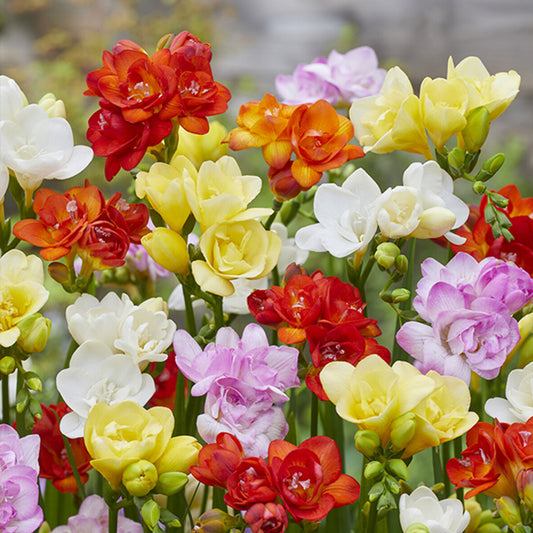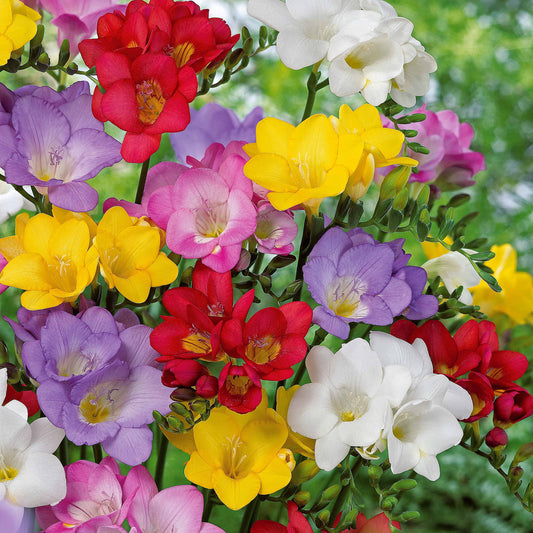Finn T. van Tilburg
1. Importance of Proper Light Exposure for Freesias
When it comes to growing beautiful freesias, one of the most crucial factors to consider is providing them with the ideal light exposure. As a passionate gardener, I understand the significance of ensuring that these vibrant flowers receive the right amount of light. In this article, I will explain the importance of proper light exposure for freesias and provide helpful tips on how to achieve optimal light levels for their growth.

1.1 Understanding Freesia's Light Requirements
Freesias thrive in bright, indirect light. They require at least six hours of sunlight each day to develop healthy foliage and vibrant flowers. Insufficient light can lead to weak and straggly growth, while excessive light can cause burns and damage to the leaves.
1.2 Benefits of Optimal Light Exposure
Providing freesias with the right amount of light exposure offers several benefits. Ample sunlight promotes photosynthesis, enabling the plants to produce energy and vital nutrients. This, in turn, strengthens the root system, enhances flower production, and improves overall plant health.
1.3 Consequences of Inadequate or Excessive Light
If freesias don't receive enough light, they may fail to bloom or produce small and pale flowers. Insufficient light can also result in stunted growth and weak stems, making the plants more susceptible to diseases and pests. On the other hand, excessive light can cause sunburns, leaf discoloration, and even death of the plant.
2. Determining the Right Light Levels
To provide optimal light exposure for your freesias, it is essential to understand how to determine the right light levels and make necessary adjustments accordingly.
2.1 Assessing Natural Lighting Conditions
Start by assessing the natural lighting conditions in your garden or growing area. Observe the amount of sunlight the area receives throughout the day. Freesias prefer bright, indirect light, so it's important to select a location that provides this type of lighting.
2.2 Supplementing with Artificial Lighting
In cases where natural light is limited or inadequate, you can supplement it with artificial lighting. Using a combination of fluorescent or LED grow lights can help provide the necessary light spectrum for optimal freesia growth. Ensure that the lights are positioned at the right distance from the plants to avoid heat damage.
2.3 Considerations for Different Growth Stages
Keep in mind that freesias have different light requirements during different growth stages. For example, they may need more light during the vegetative stage to promote foliage growth and less light during the flowering stage to encourage flower production. Adjust the light exposure accordingly to meet the specific needs of your freesias.
3. Factors That Influence Light Exposure
Several factors can influence the light exposure of your freesias. Understanding these factors will help you make better decisions regarding their placement and care.
3.1 Geographic Location and Climate

The geographic location and climate play a significant role in determining the amount and intensity of natural sunlight available for your freesias. Consider the specific light conditions in your region and choose freesia varieties that are well-suited to your climate.
3.2 Seasonal Light Variations
Seasonal light variations, such as shorter or longer days, can impact the light exposure of your freesias. In some regions, winter sunlight may be limited, requiring the use of artificial lights or the use of grow tents or greenhouses to protect the plants.
3.3 Positioning and Orientation
The positioning and orientation of your freesias can affect their light exposure. Place them in an area where they can receive maximum sunlight, taking into account any nearby buildings or structures that may cast shadows.
3.4 Light Intensity and Duration
Ensure that your freesias receive the right balance of light intensity and duration. While they require bright light, prolonged exposure to intense sunlight can be detrimental. Monitor the light levels and adjust as needed to prevent light stress or damage.
4. Tips for Providing Optimal Light for Freesias

Here are some practical tips to help you provide optimal light for your freesias:
4.1 Placement in a Well-Lit Area
Select a well-lit area for your freesias, preferably one that receives at least six hours of sunlight each day. If planting indoors, position them near a window that provides bright, indirect light.
4.2 Monitoring Light Levels
Regularly monitor the light levels your freesias receive. Use a light meter or observe the growth and appearance of the plants to ensure they are getting enough but not excessive light.
4.3 Adjusting Light Exposure as Needed
Adjust the light exposure of your freesias based on their growth stage and the prevailing light conditions. Increase or decrease the amount of light they receive to promote healthy growth and flowering.
4.4 Preventing Light Stress and Damage
To prevent light stress or damage, protect your freesias from intense midday sun, especially during hot summer months. Use shading materials or adjust the position of the plants to provide them with some relief from direct sunlight.
5. Conclusion
In conclusion, providing the ideal light exposure is crucial for the successful growth of freesias. Understanding their light requirements, determining the right light levels, considering influencing factors, and following practical tips can help you achieve optimal light conditions for your freesias. By ensuring they receive adequate sunlight, you can enjoy the beauty and fragrance of these delightful flowers in your garden or indoor space.






